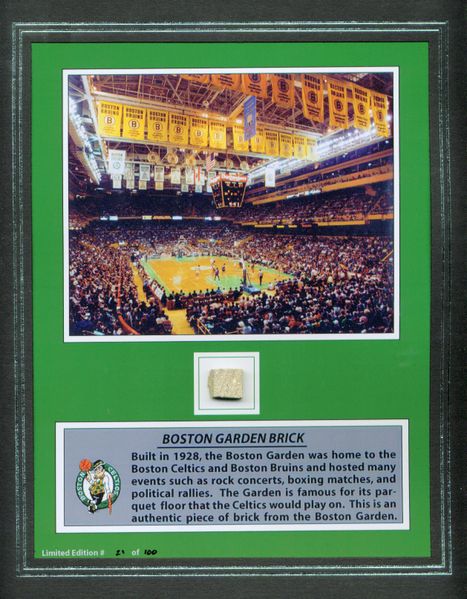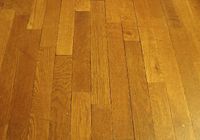

Boxing promoter Tex Rickard, who built the third incarnation of New York's Madison Square Garden, built the "Boston Madison Square Garden" in 1928. The name got clipped to Boston Garden. The Garden sat on top of North Station, a train station, which is a hub for MBTA Commuter Rail trains and Amtrak trains. Over the years the Garden was home to the Boston Celtics and the Boston Bruins. It hosted many events, including rock concerts, amateur sports, boxing and wrestling cards, circuses and ice shows. It was also used as an exposition hall for political rallies such as the famous speech by John F. Kennedy in November, 1960. The last NHL hockey game played there took place on Sunday, May 14 1995. It was Game 5 of an Eastern Conference quarterfinal series between the Boston Bruins and New Jersey Devils. The Devils edged the Bruins, 3-2, winning the series 4 games to 1. The facility hosted the NBA All-Star Game in 1951, 1952, 1957, and 1964, and the NHL All-Star Game in 1971. It additionally was the site of the 1993 WWF Survivor Series. The NCAA Frozen Four was contested there from 1972-74.
Sections of the famous parquet floor and bricks of the garden were sold as souvenirs following its demolition.
The Garden was famous for its parquet floor that the Boston Celtics played on; however, the parquet floor was not originally part of the Garden. The parquet floor was built and installed in the Boston Arena, but was moved to the Garden in 1952. It is said that the Celtics knew which way the basketball would bounce off any particular section of the floor, and that this was one contributing factor to the Celtics' many National Basketball Association championships. The floor became as much a part of Boston sports lore as the Green Monster of Fenway Park. When Fleetcenter was completed, the floor was moved there, but was soon replaced by a replica floor when the old floor became too old to play on. Rock band Led Zeppelin was banned from performing at the Boston Garden as of 1975 after fans were allowed to stay in the building due to sub-freezing temperatures but fans rioted and the then-mayor of Boston banned the group for five years. KISS were banned from performing at this very venue as well. Rock band Pink Floyd were the first band to perform at the Boston Garden with a stage set that costed over $1 million on their 1977 Animals tour.
Rock band Jethro Tull performed at the Boston Garden as a headlining act more times than any other band with 15 headlining performances from 1972 to 1980.
Rock band Grateful Dead performed at the Boston Garden more times than any other band with 24 accumulated performances from 1970 to 1990.
The Garden was infamous for several design flaws as well, such as seating that was obstructed by enormous cement pillars. Some seats were even directly behind them. The hockey rink was undersized, which threw visiting players off their games. Its visitors dressing room was notoriously small, hot, and underserved by plumbing; the Los Angeles Lakers developed a special hatred for it. Rats made the bowels of the Garden their home and, for a time, monkeys escaped from the circus lived in the rafters. The Garden had no air conditioning, and the electrical systems were notoriously unreliable. The Boston Bruins' last two Stanley Cup finals appearances were both disrupted by power outages. On May 24, 1988 a power transformer blew up during Game 4 of the finals series between the Bruins and the Edmonton Oilers: the contest officially ended in a 3-3 tie. Two years later, on May 15, 1990, the lights went out during an overtime finals game between the same two teams. Luckily, the lights got turned back on this time, and Game 1 of the series ended with a 3-2 triple overtime win for the visiting Oilers.


The parquet floor will be making the transition from the Boston Garden into the FleetCenter - the Celtics' new home. The parquet floor is the focus of fascination for many fans and the following is a sampling of the questions that tend to be asked:
Q. Is this the same floor that was used from the original days of the Celtics?
A. In 1946, Celtics Owner Walter Brown planned a basketball floor to be built in Boston Arena (presently the home of Northeastern University's Huskies and has been renamed the Mathews Arena) where the Celtics played home games along with Boston Garden. Pieces of the floor have replaced over the years; however, some of the pieces may be the same as used in 1946 when the floor was originally built.
Q. How was the floor built?
A. It was built in 1946 of hardwood, from a forest in Tennessee, originally used to build barracks during World War II. The cost was in the $10,000-$11,000 range. The floor was manufactured because of a shortage of materials following World War II. This shortage caused the East Boston Lumber Company to construct the floor from scraps, fitting them together in an alternation pattern. The original parquet floor was moved from Boston Arena to Boston Garden in December, 1952.
Q. How many squares of parquet are used and what are the dimensions?
A.The parquet floor has 247 panels, each approximately 5'-by-5' and 11/2" thick. The panels are held together by wood planks and brass screws, with the help of 988 bolts. The floor is pieced together in two and 1/2 hours by a group of men known as the "Bull Gang."
Q. How many bolts does it take to secure the floor?
A. There are 988 bolts used.
Q. Where are the dead spots?
A. From Red Auerbach: "The parquet floor is synonymous with the Celtics. It is a good floor, a very good floor. The so-called dead spots on the floor? If teams felt it was a poor floor, I used it for an advantage by playing with their minds. That usually worked. When teams did beat us on the rare occasion, they never complained. The strange thing was that there were more dead spots in old Madison Square Garden than in Boston. Believe me, I played and coached there on many occasions; I know."
Q. When was the logo put at center court?
A. 1974-75 season.
Q. What about the resurfacing of the floor?
A. It was laid in 1946, and has been resurfaced several times including 1972, 1993, and in 1995 when the floor was moved into the Fleet Center.

